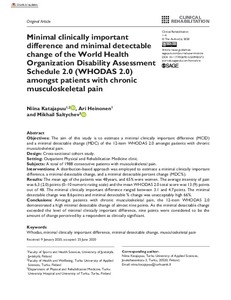Minimal clinically important difference and minimal detectable change of the World Health Organization Disability Assessment Schedule 2.0 (WHODAS 2.0) amongst patients with chronic musculoskeletal pain
Mikhail Saltychev; Ari Heinonen; Niina Katajapuu
Minimal clinically important difference and minimal detectable change of the World Health Organization Disability Assessment Schedule 2.0 (WHODAS 2.0) amongst patients with chronic musculoskeletal pain
Mikhail Saltychev
Ari Heinonen
Niina Katajapuu
SAGE PUBLICATIONS LTD
Julkaisun pysyvä osoite on:
https://urn.fi/URN:NBN:fi-fe2021042821785
https://urn.fi/URN:NBN:fi-fe2021042821785
Tiivistelmä
Objectives: The aim of this study is to estimate a minimal clinically important difference (MCID) and a minimal detectable change (MDC) of the 12-item WHODAS 2.0 amongst patients with chronic musculoskeletal pain.
Design: Cross-sectional cohort study.
Setting: Outpatient Physical and Rehabilitation Medicine clinic.
Subjects: A total of 1988 consecutive patients with musculoskeletal pain.
Interventions: A distribution-based approach was employed to estimate a minimal clinically important difference, a minimal detectable change, and a minimal detectable percent change (MDC%).
Results: The mean age of the patients was 48 years, and 65% were women. The average intensity of pain was 6,3 (2.0) points (0-10 numeric rating scale) and the mean WHODAS 2.0 total score was 13 (9) points out of 48. The minimal clinically important difference ranged between 3.1 and 4.7 points. The minimal detectable change was 8.6 points and minimal detectable % change was unacceptably high 66%.
Conclusions: Amongst patients with chronic musculoskeletal pain, the 12-item WHODAS 2.0 demonstrated a high minimal detectable change of almost nine points. As the minimal detectable change exceeded the level of minimal clinically important difference, nine points were considered to be the amount of change perceived by a respondent as clinically significant.
Kokoelmat
- Rinnakkaistallenteet [19207]
